Building the dream
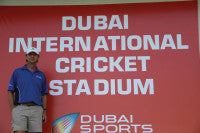 A chance meeting with Rodney Marsh - with whom he had worked preparing pitches in the 90s for the AIS (Australian Institute of Sport) cricket team - brought Tony Hemming to the greatest challenge of his career so far. And that's saying something for a man whose CV includes presiding over the Melbourne Cricket Ground, the Colonial Stadium and the Oval.
A chance meeting with Rodney Marsh - with whom he had worked preparing pitches in the 90s for the AIS (Australian Institute of Sport) cricket team - brought Tony Hemming to the greatest challenge of his career so far. And that's saying something for a man whose CV includes presiding over the Melbourne Cricket Ground, the Colonial Stadium and the Oval.
Whilst playing cricket socially at Sharjah Cricket Club in the UAE, during a stint as head groundsman at the King Fahd stadium in Saudi Arabia, Tony re-introduced himself to the coaching legend, who told him about his involvement with an exciting new project in Dubai.
The glamorous and rapidly developing Emirate was to be home to a new centre of excellence for sport.
Dubai Sports City is the vision of three leading entrepreneurs from the United Arab Emirates - Abdulrahim Al Zarooni, Abdulrahman Bukhatir and Abdulrahman Falaknaz - to create one of the world's premier sporting destinations. This is in line with the overall vision of HH Sheikh Mohammed bin Rashid Al Maktoum to offer world class sporting infrastructure in Dubai and making it a destination for the sporting world.

It's been conceptualised as a city within a city where, on the doorstep, are state-of-the-art sports venues and international sporting events, sports academies providing a platform for youth development, recreational sporting facilities, residential and commercial developments, together with all the related amenities expected in a purpose-built city, including international schools, medical facilities, hotels, community centres and entertainment venues.
At the heart of the plans was a cricket academy, to be run in conjunction with the International Cricket Council (ICC), which had recently relocated to the sunny climes of the Gulf. The vision was to recreate playing conditions from around the world, allowing cricketers to train for international matches in a central location, as well as taking advantage of high tech performance development equipment to hone their skills.
Tony arrived at Dubai Sports City in February 2007, with the brief to take over turf management at the Dubai International Cricket Stadium and the ICC Global Cricket Academy (ICCGCA) in his role as Head Curator.
Building the dream
"The stadium had been designed by the German company, GMP, in conjunction with the ICC. I was familiar with GMP as they had also designed the King Fahd stadium," Tony explains.
 Main contractors, Alpine Bau Deutschland and Belbadi Engineering, worked with field contractor Gregori International, and Tony was able to use his considerable experience to consult on turf related issues.
Main contractors, Alpine Bau Deutschland and Belbadi Engineering, worked with field contractor Gregori International, and Tony was able to use his considerable experience to consult on turf related issues.
"The initial budget for the square was very low, but the design showed that the profiles were too complex. By simplifying these, funds were released for other aspects of the development. I was also able to utilise my contacts - for example, we gained sponsorship from Toro for the irrigation heads and compute control system."
Tony also had support from a highly authoritative source - the acclaimed turf writer, Keith McIntyre, was sent a copy of his comments on the proposed drainage system design by the contractor, and backed Tony's suggestions completely. The sixteen herringbone system, with drains at 7m spacings, was duly installed and, unlike many systems in the city, copes well with sudden downpours.
A major challenge for growing grass in a stadium environment was one that Tony was familiar with - the shade created by its spectator friendly 'bowl' design and the 25,000 seater grandstands.
Grass varieties were chosen to provide ground cover in a climate that delivers temperatures from 20OC in the winter to 50OC in the summer. The stadium gets four and a half hours of sun in the winter and six and a half in the summer.
Bermuda grass is rotated with ryegrass, and the hectic fixture schedule means that Tony and his team have to transition the species alongside the matches. In 2010, there were 101 days of activity at the stadium, of which twenty-three were international cricket days. The wicket for the inaugural Test match was prepared during the  One Day International series in November.
One Day International series in November.
Ryegrass was then seeded immediately after the Test. In the spring, the sun burns off the ryegrass, allowing the Bermuda to come through.
The stadium is also used for other sports, including NFL, football and for concerts.
"We had the UFL (UAE national league) playing in the stadium at the start of the season, so I have to be able to provide a full cover of grass year round," Tony comments. "I also feel the quality of the outfield is important for cricket - the outfield is quick and we will roll to make it faster if necessary, but I'd rather it was challenging than superfast."
Maintenance
With the pressure on the stadium, Tony believes that his job is to grow grass the best way possible, which means encouraging a strong root system.
"We keep the grass hungry, using low levels of nitrogen, plenty of potassium and adding manganese, iron and trace elements to green up."
"The low N regime means that the turf does not create a lot of leaf, so thatch is not a problem, and grass clippings go back on to provide organic matter rather than being boxed off."
 Protecting the outfield is key - no training is permitted in the shaded areas, and Terraplast sheets are used for concerts, carried onto the pitch in purpose built trailers. Regular aeration and application of spring fungicide also help to keep the turf healthy.
Protecting the outfield is key - no training is permitted in the shaded areas, and Terraplast sheets are used for concerts, carried onto the pitch in purpose built trailers. Regular aeration and application of spring fungicide also help to keep the turf healthy.
The Verti-drain is used once a month, either at 250mm or 150mm, and the outfield is solid tined with a Toro Procore 880 in between. Aeration also comes into play to help with the nutrient balance.
"The soil is calcareous, but much of the calcium is locked up, so I aerate, flush the soil with water and then add a sulphur product. I also use acid injection to correct the high pH, which can affect iron take up. Sulphuric acid takes the pH from 7.8 down to 5.5 within the water."
Getting accurate, independent soil analysis is extremely difficult, he says, and this is one aspect that he hopes to work on with the ICC and industry partners.
"This would be the ideal location for a centre for turf research, and it is a development I would be very keen on," Tony comments.
He also has an unconventional approach to watering compared to usual practice in the region, where most groundsmen water daily - 20mm of water is applied to the outfield once a week in winter, going up to three times a week when managing the Bermuda during even the hottest summer.
"The Bermuda grass looks brown and woody in the winter but, underneath, the root system is really strong," says Tony. "If you take a plug you can see the roots travelling all the way down through the profile."
Tony's 'tough love' approach has been driven in an unusual way - when he left the MCG it was to become a competitive cyclist, and he studied nutrition during this period which he has since applied to turfcare.
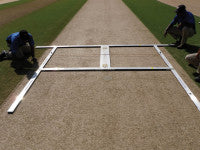 The greatest threat to the turf, Tony reckons, is insects, and control requires a close eye on the temperature.
The greatest threat to the turf, Tony reckons, is insects, and control requires a close eye on the temperature.
"Insects are rampant here - Bermuda mite gets into the root and chews it apart so that they can't penetrate the soil. Ideally, we should spray for it twice a month, especially when playing under lights, as it can quickly take over. Cutworm is another problem. At its worst, you can see the grass literally shaking with it. The insects are not active in hot weather but, when the mercury falls to 36OC, and the soil temperature is 28-30OC, that's when you need to take action."
Seed selection focuses on purity, with the seeded Bermuda Princess 77 being the variety of choice for the outfield, rotated with Jacklin Seeds ryegrass Top Gun.
"There is no pure Bermuda on turf farms in the region, and you can't always risk taking sprigs from the golf courses."
On the wicket, he uses Bermuda Turfway 419, selected for its fine leaf and close growing qualities, with sprigs taken from the adjacent Els golf course, another part of the massive Dubai Sports City complex.
"Although Dubai is hot, the sun is actually filtered due to the levels of construction in the city, which creates a still, humid, dusty atmosphere and grass tends to grow vertically, rather than laterally, so there's no need to scarify."
The intensive programme means a tough job to get the square back for the next fixture, but Tony says that, by getting the construction right and nurturing the pitch, it is achievable.
As each strip is prepared, it is first cut to 6mm from its maintenance height of 9mm, going down to 4mm during matches, with a 3.5mm cut just before.
"I'm not a believer in very close cutting - at 2mm you can expose the crown and cause damage."
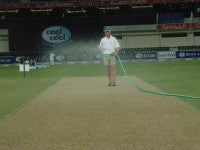 Watering the square is achieved with a soaker hose, wetting the profile to 100-150mm. The soaking system is connected to the irrigation controller, allowing a soaking cycle of 5min every hour. An initial roll will usually commence from 24 to 48 hours afterwards, depending on the time of year.
Watering the square is achieved with a soaker hose, wetting the profile to 100-150mm. The soaking system is connected to the irrigation controller, allowing a soaking cycle of 5min every hour. An initial roll will usually commence from 24 to 48 hours afterwards, depending on the time of year.
Tony explains: "Cross rolling first, followed by a length roll over the first three days is very important. Rolling produces the required firmness and a smooth surface; the pitch has to crack to allow oxygen in, and this is a very significant stage in the recovery of the pitches."
"I am used to heavy clays in Australia, which can get very hard, creating great bounce and pace, but they can get compacted, which makes it hard for the grass to grow, and I have applied the same principles here. We plant by hand at 75mm spaces, and aim to grow grass first and get roots down through the profile. Then we compact the pitch."
Tony uses different weights of roller depending on the pitch soil origin; he suggests that 1.5 tonnes is enough on Pakistan clays, although a heavier roller is used occasionally.
He reckons each strip takes around thirteen hours preparation, and timing of rolling has a great influence on the cracking pattern.
"We currently have to take plugs of the cricket pitch and check the firmness of the soil for the right time to get optimum compaction."
The native climate means that Tony often has to think on his feet. Bermuda grass, known for its tolerance to heat, was showing signs of disease in summer 2010. The soil temperature of 40OC was stressing the plant and it was not responding to fungicides.
"It became apparent that water in the irrigation storage tanks was heating to a level that was causing the damage, and a swap from light hand watering to automatic watering at night was a better way forward," he explains, citing as another example: "From June to August, the rollers get too hot, so we can only roll between 7.00-8.00am."

A staff of thirteen take care of the cricket, hockey, rugby and football stadiums as well as the ICCGCA. Initially, Tony, and his Assistant Curator, Toby Lumsden, had to be very hands on in the cricket stadium.
"The staff are now getting more confident in their roles, so that I am able to leave them to it in the stadium and focus more on the GCA, but it has taken time to develop their skills," he explains.
Machinery and equipment
Currently, all equipment is kept at the stadium whilst a groundsman's compound is built at the ICCGCA, but the large unit under the grandstand provides space for a full time mechanic to work and plenty of storage.
Machinery is procured from distributor Turf Industry Supplies, which equips all of Dubai Sports City's facilities under Tony's direction.
Toro is the main brand, with which Tony has a long relationship, and there are three Lamborghini tractors, two 51hp R155s and an 85hp RF90.
 Australian brand Mentay is the choice for the selection of pedestrian, mounted and ride on rollers, and for a soil crusher used to prepare the clay, while Graden pedestrian and tractor mounted scarifiers are also in the armoury.
Australian brand Mentay is the choice for the selection of pedestrian, mounted and ride on rollers, and for a soil crusher used to prepare the clay, while Graden pedestrian and tractor mounted scarifiers are also in the armoury.
Four Club Car utility vehicles are described as essential tools. "It's 1.5km between the stadium and the cricket academy, so moving men and equipment around can be a major chore."
Tony admits that there is a casual attitude to chemical storage in Dubai, but is gradually creating more order in the inputs store.
"I try to keep it simple anyway, using a small selection of proven products. It can be difficult to get new chemistry approved in the region or even to import certain materials - it took two years to get a permit for the clay!"
It would be easy to think that at least one issue that Tony doesn't have to face is rain, but with the dusty environment - he has calculated that 27 tonnes of dust falls on the stadium each year - any precipitation quickly turns the silty dust to mud.
"We have 75mm of rain a year, but that can fall in three days, usually in February. We don't have the big headache of covers on a regular basis, but had to use them during the Internationals."
A focus for global cricket
 With the stadium up and running, attention turned to the ICC Global Cricket Academy, which was inaugurated in October 2010.
With the stadium up and running, attention turned to the ICC Global Cricket Academy, which was inaugurated in October 2010.
The ICCGCA will boast state of the art storage, maintenance and washdown facilities for machinery, as well as canteen, washroom and residential provision for the groundstaff.
"It will make life a lot easier for the team - you can work very long hours as a groundsman and good facilities are essential," says Tony.
In contrast to the stadium, the two ovals at the academy have a domed 300mm profile to allow natural drainage, and cut construction costs. During the final stages of the development, these were grassed over and, at the handover, Tony was faced with the task of taking the surface off and growing Bermuda grass in, and then as the weather turned cooler, replacing it with ryegrass.
Each oval has ten wickets - five of Australian and five Asian clay construction - chosen to attract maximum bookings and, thereby, revenue. The schedule is no less punishing than for the stadium - 144 days cricket is planned for each oval in 2011.
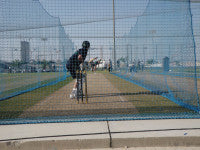 "There will be six pitch rotations a year and, ideally, each strip should get six weeks recovery time, although we can do it in five if necessary. We'll keep a lot of grass cover - no less than 5mm - and use covers."
"There will be six pitch rotations a year and, ideally, each strip should get six weeks recovery time, although we can do it in five if necessary. We'll keep a lot of grass cover - no less than 5mm - and use covers."
In February alone, teams from Canada, the Netherlands, Ireland, Zimbabwe and Scotland travelled to Dubai to try out the facilities for themselves. Each pitch is prepared for four days' play to give the players experience of how its characteristics change as matches progress.
"I'm keen to be able to offer good standard pitches that are consistent and give the players an idea of what to expect on tour. It's crucial to show that this can be done in the Middle East. We can adapt preparation techniques for each type of surface - for example we have a concrete filled roller which is ideal for Australian pitches."
The ovals will also give up-and-coming players competitive experience, with events including the Gulf Cup for under-17s and under-12s.
As with any new pitch, the GCA's facilities will take time to establish, and Tony notes that, while the Pakistan wickets were perfect from the start, the Australian strips continue to evolve.
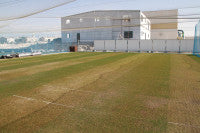 "Due to the swelling of montmorillenite type clays of Australia, the soil after construction and first preparation have shown a few high spots, and this will be adjusted with some extra diagonal rolling and topdressing at the end of the season."
"Due to the swelling of montmorillenite type clays of Australia, the soil after construction and first preparation have shown a few high spots, and this will be adjusted with some extra diagonal rolling and topdressing at the end of the season."
International teams will also get the opportunity to practice on surfaces from other parts of the world, in an extensive practice area offering a bowlers' run up of 30m and fielding area alongside, and no less than thirty-eight strips, including English wickets constructed from Ongar loam.
"The English wicket was planted with Top Gun Ryegrass in October and quickly produced dense cover, although it was prone to disease. We have since reduced the seed rate to give a sparser canopy and less tendency to disease. It can only be used for four months of the year and then the ryegrass is finished."
 Tony comments that an ideal would be to be able to climate control the practice strips eventually, giving a more accurate replication of how the ball behaves in different levels of humidity and air movement.
Tony comments that an ideal would be to be able to climate control the practice strips eventually, giving a more accurate replication of how the ball behaves in different levels of humidity and air movement.
"We'll only know whether we've got it right with these wickets as international teams use them - their feedback is crucial to our development."
Even the net system is high tech - all side nets slide across to allow the groundsmen access, and their design also incorporates a canopy at the front to make a safe area for umpire training.
Indoors, the high tech theme continues, with four bowling machines offering invaluable practice facilities - including the innovative 'iron mike' machines, and Pro Batter, which offers computerised footage of leading bowlers against which batsman can pit their skills. During 2011, full video review facilities will be added, allowing teams and their coaches to analyse their performance instantaneously.
Training and development
Tony is well aware that producing 144 days cricket on ten pitches is going to require his team to be at the top of their game in 2011, and staff training and development is very much at the top of his agenda.
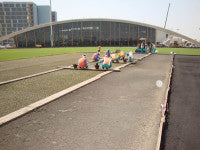 His goal is to get the groundsmen on his wavelength, developing their understanding of the role and confidence in their abilities, and an important strand of this will be his plans to develop a curator's course for the ICC, based on the procedures he has developed for the GCA.
His goal is to get the groundsmen on his wavelength, developing their understanding of the role and confidence in their abilities, and an important strand of this will be his plans to develop a curator's course for the ICC, based on the procedures he has developed for the GCA.
"Not much exists in the UAE. When I did my own training in Australia, it was based on golf course maintenance, with very little content on cricket, so it is vital that we can provide specialist training. At the moment it is down to each head groundsman to pass on his own skills."
"However, there is a tendency to keep some of the 'secrets' to yourself. The ECB has done a good job in developing training programmes, but Cricket Australia has not produced much written material, although they have the expertise of people like Keith McIntyre at hand. I would like to write a book on my experiences in the UAE, and I have a lot of useful photographs - the key to a training manual is knowing what shots to take."
Tony says that the achievements of his team in delivering pitches for the Test and One Day Internationals, under intense time pressure, have shown that their approach is correct and that on-the-job training really works.
"We give our groundsmen a daily task, show them how to do it, have a run through and make an assessment. But, now they need to be able to gain recognised qualifications for their career development."
Tony believes that there is a great future in the Middle East for turf management - witness the growing calendar of major events taking place in Dubai, Abu Dhabi and Qatar - and that the ICCGCA can be at the forefront of this.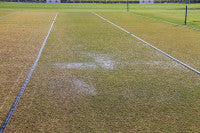
"The next challenge is to create standards and rules for the pitches - at the moment line marking and pitch set up are very much at the mercy of the umpire, so it is hard for the groundsman to know where he stands. It would be ideal to create standards that are globally acknowledged by umpires.
"Despite what is commonly perceived, cricket groundsmen are neutral - it would not be in their interests to set up the pitch for a particular team. The greatest satisfaction is achieved from producing a pitch which is fair and consistent and delivers exciting cricket. I like seam and spin, but I believe that the match should not be all about the batsman. There's a lot of talk about the groundsman creating the pitch conditions for a certain type of play but, in fact, it is the five days of use that dictates play."
An energetic and enthusiastic advocate of his sport and of groundsmanship, Tony Hemming says that he is looking forward to giving international teams a feel for local conditions at the GCA.
Despite a seemingly massive workload, his thoughts are very much to the future.
"There is so much potential here. I'm already in talks with international companies, such as Toro and Redexim, on the opportunities to hold workshops in Dubai, to get involved with the development of turf laboratories and to contribute to the Global Cricket Academy as a centre of groundmanship excellence, as well as playing excellence. The possibilities are endless."
